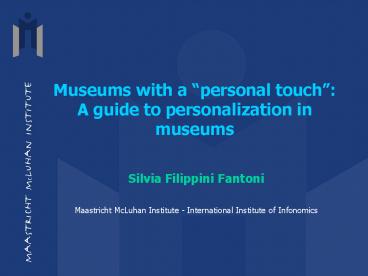Silvia Filippini Fantoni PowerPoint PPT Presentation
1 / 33
Title: Silvia Filippini Fantoni
1
Museums with a personal touch A guide to
personalization in museums
- Silvia Filippini Fantoni
- Maastricht McLuhan Institute - International
Institute of Infonomics
2
Personalization what? (general)
- Personalization is about building customer
loyalty by establishing a one to one relation by
understanding the needs of each individual and
helping satisfy a goal that efficiently and
knowledgeably addresses them in a given context. - Doug Rieken
- In Personalized view on Personalization
3
Personalization and museums
- The necessity to take into consideration the
specific interests of the final user is very
popular also in the cultural sector, where it
is progressively affirming as a new paradigm for
providingknowledge
4
Personalization in museums why?
- External factors
- The challenge of greater self-sufficiency pushed
museums towards a more audience-oriented approach
- Internal factors
- The affirmation of constructivist theories has
pitted the needs of the visitor against the
tradition of the collection
5
Who are the visitors and what do they want? I
6
Who are the visitors and what do they want? II
7
Technology provides the tools for
personalization, because it supports
- Different forms of presentation
- Different modes of access to the information
- Different layers of information
- Different interactive links between subjects
8
Towards a personalized augmented museum
9
HP Cooltown
10
Beyond the museum the real, the remote, the
potential and the follow-up visitors
11
Personalization How?
- CHOICE
- Give the visitors the freedom of choosing what
they want to see and how they want to see it
- ADAPTIVITY
- Create software systems that automatically adapt
the information content and presentation to the
visitors needs and interests.
12
Giving visitors choice on line
- Virtual Tours
- Digital Collections Compass, Microgallery, EMP
Digital Collection - http//www.thebritishmuseum.ac.uk/compass/
- Robotic Avatars Tourbot
- http//www.informatik.uni-bonn.de/tourbot/index2.
html
13
British Museum digital collection
14
TOURBOT
15
Giving visitors choice on site IRandom-access
audio guides
- Antenna Audio
- Acoustiguide
- Tour-mate
- JVC Audio
16
Giving visitors choice on-site II3rd generation
audio-guides
- MUSEpad
- Ansae Gnole
- SmARTour
- Minpaku Electronic guide
- E-Docent
- MEG tour guide
- iGo
17
E-Docent
18
Adaptivity giving visitors what they want
without them having to ask I
- Adaptability
- Systems that provide the end user with tools that
make it possible to change the system
characteristics according to the context of use - Ex. Web site of the Marble Museum
- http//giove.cnuce.cnr.it/servlets/StartVisit
19
Tourist-view
20
Student-view
21
Expert-view
22
Personalized-view
23
Adaptivity giving visitors what they want
without them having to ask II
- Adaptivity
- Systems that are able to change their own
characteristics automatically according to the
users model
24
Adaptivity some examples
- ILEX
- Hyperaudio
- HIPS HIPPIE
- Museum Wearable
- Archeoguide
- GUIDE
25
The importance of an efficient user model HIPS
- COMBINE
- Stereotypes
- Dynamic modeling
26
At which levels can we personalize?
27
View some examples
- Structure-based personalization
- Revealing Things
- http//www.si.edu/revealingthings/back_pages/
- Arrangement-based
- personalization
- Art Tales
- http//www.wildlifeart.org/ArtTales/
28
Revealing Things
29
Personalization an evaluation Does it really
work?
- Freedom and Flexibility
- Adaptivity and the problem of information
overload - Serendipity
- The social context
- Necessity for more studies!!!
30
The future of personalization in museums
- Further exploitation of Context awareness through
mobile devices Ex. CIMI-Handscape and
HP-Cooltown - Further blending of the physical and the
information space Ex. PEACH - Continuity (the persistency of a user profile)
31
Personalization Ultimate consequence for museums
and visitors
- Personalizing means presenting alternative ways
of conceiving the meaning of an object. - Visitors start making sense on their own out of
the realities they see and they might not get the
content the way curators expected them to.
32
Conclusions
By giving visitors the freedom to experience the
exhibition the way they want, a new mode of
interaction between visitors and museums is
formed
- Museums
- The perception of the museum as an institution
changes from a withholder/controller to an open
container of knowledge
- Visitors
- From passive spectators to living elements of the
exhibition
33
s.filippini_at_mmi.unimaas.nl

